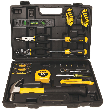Prepping Walls for Painting
Written by Lee Wyatt (last updated January 24, 2022)
When you are getting ready to repaint a room, you simply can't slap some new paint on the old stuff. Well, you could, but it won't look all that good. The first step to painting your room like a pro lies in prepping walls for painting. While this may be a time consuming, and thus often ignored, step in painting a room, it is still a vital one. If you need to prep your walls for painting, then all you need to do is follow these simple guidelines, and you will soon have a blank canvas that is ready for your artistry.
- Clean. Just as with many other projects, the very first thing that you will need to do is clean the walls. Properly cleaning, dusting, and even (if necessary) washing the walls will give you a good idea of the other work that needs to be done. In addition to giving you a clear picture of what other work needs to be done to your walls, this will also remove the dust, grime, oils, and other general crud that will prevent the paint from adhering to the walls properly.
- Repair. After you have cleaned your walls, take stock for a moment, and see if there is anything that needs to be fixed or repaired. This step in prepping for walls will go a long way to helping ensure that you have your walls look the best it possibly can. Look for any water damage, cracks, gashes, or other types of damage, and repair them if necessary. For more information on how to repair these kinds of damages, type "repairing walls" into the Home.Tips.Net search box, and you will find several articles that tell you how to do exactly this.
- Painter's tape. Once you have your walls properly cleaned and repaired, it is time to lay down the painter's tape. This will help protect those elements on your wall that you do not want painted. For example, if you have a light switch, window frames, chair rails, or wainscoting that you don't want painted then you need to lay down some painter's tape. After you have placed some painter's tape down, lay down a few drop cloths, sheets, and newspapers to protect the other things you don't want to have any paint on.
- Prime it. After you have cleaned, repaired, and the painter's tape laid out it is time to prime your walls. This step is absolutely necessary to ensure that you get the color that you want, as well as ensuring that the paint sticks to the wall. For example, if the new color you are going to be painting your wall is lighter than your old one, you need to prime the wall to help get the proper shade. This is due to the darker underlying paint "coloring" the lighter top coat.
Now that you have finished priming, you have completed prepping your walls for painting. All that you have left to do is allow the primer to dry completely, and then to begin painting. Remember to take your time, and to have fun. This will help ensure that you get exactly the results that you want.
Author Bio
Lee Wyatt
Contributor of numerous Tips.Net articles, Lee Wyatt is quickly becoming a regular "Jack of all trades." He is currently an independent contractor specializing in writing and editing. Contact him today for all of your writing and editing needs! Click here to contact. Learn more about Lee...
Handling Window Treatments
Window treatments can help make or break the look and decor of any room. However, just because you may have the perfect ...
Discover More
Repairing Cracks in Plaster Walls
While plaster may be a very popular building material, it is also somewhat susceptible to cracks. If you don't take the ...
Discover More
Repairing a Running Toilet
Perhaps the single most common plumbing problem in the bathroom is to have a running toilet. Repairing a running toilet ...
Discover More
More Home Improvement Tips
Painting Vinyl Siding
Vinyl siding is a popular choice among many home owners due to the durability, and ease of maintenance that it shows. ...
Discover More
Painting Tool Necessities
Just as with any task, when painting a room you will need to make sure that you have the correct tools. Surprisingly ...
Discover More
Deciding Between Latex and Oil-Based Paints
When talking about a painting project around the home, there are really only two choices in paint-latex or oil based. But ...
Discover More

Comments